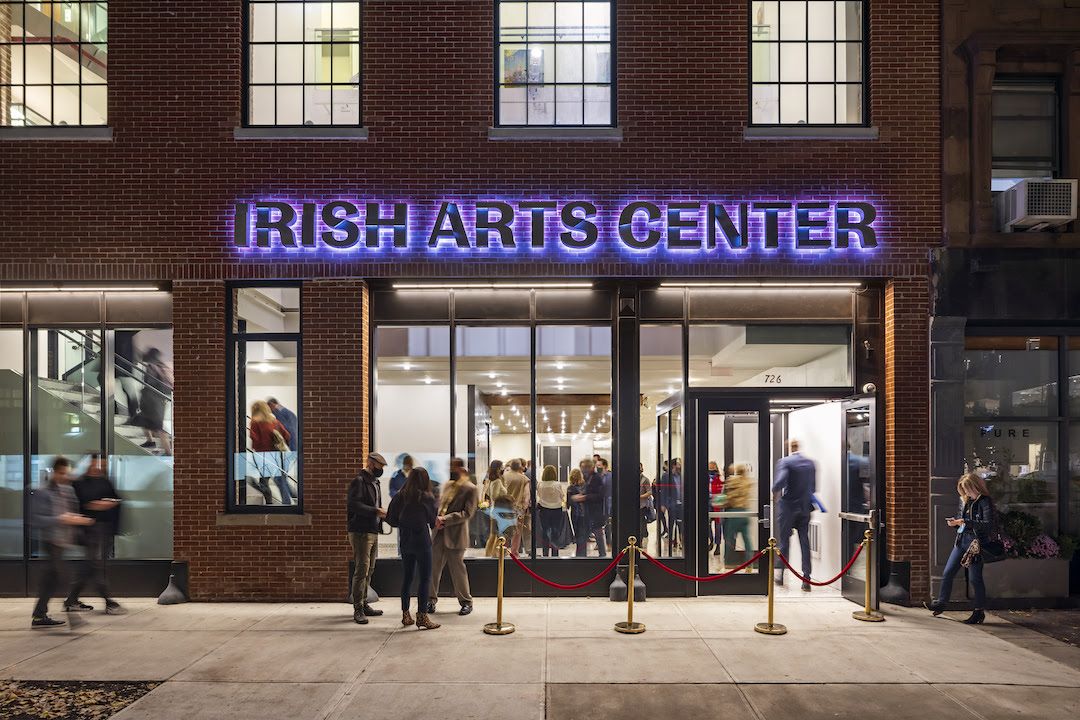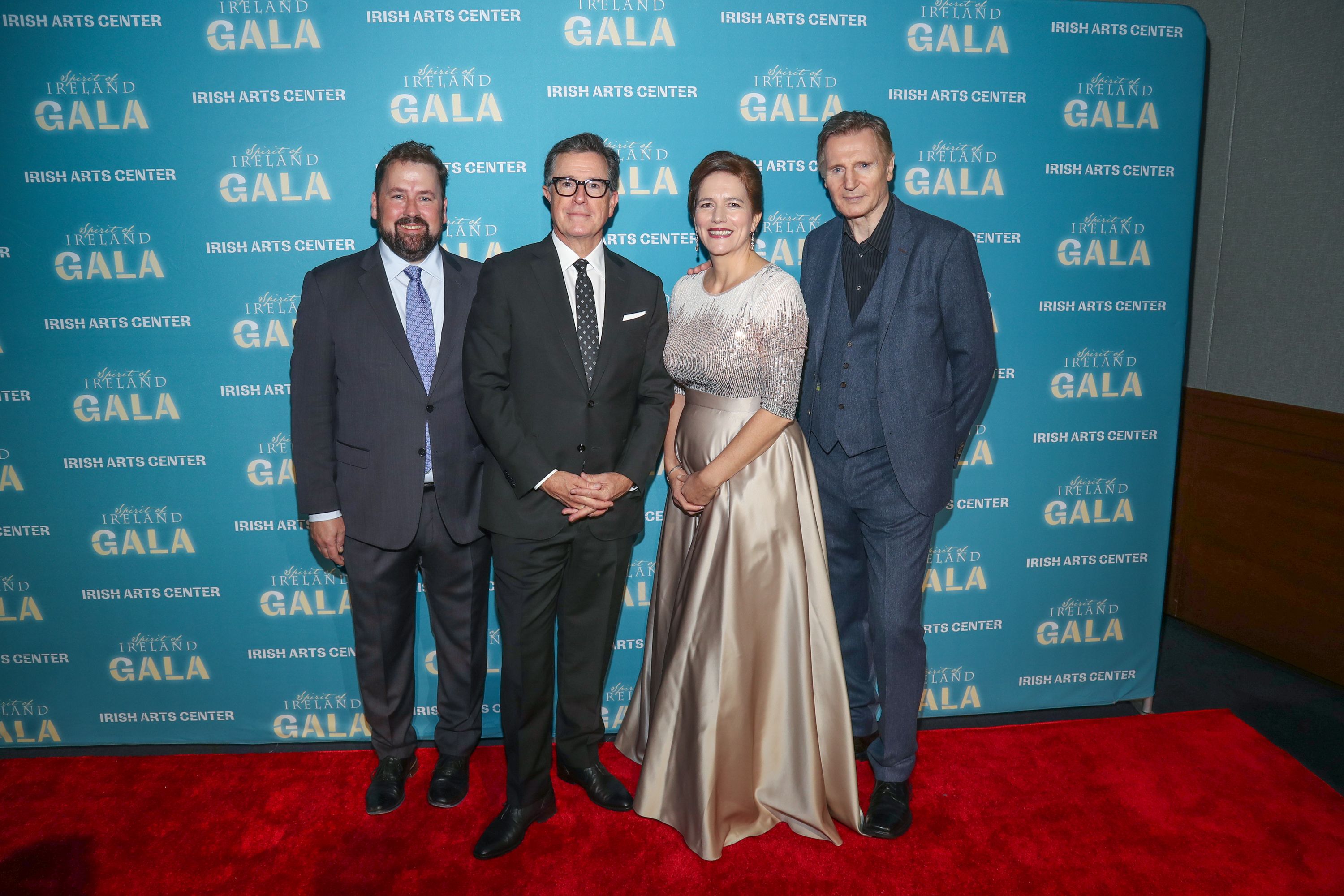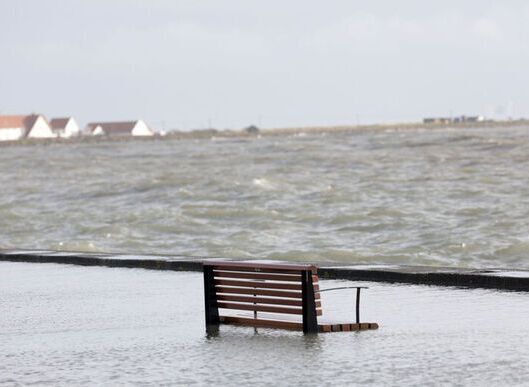“We’re seeking to offer a full night-out experience,” said Aidan Connolly, the executive director of Irish Arts Center
“There’s something pulling you in terms of programming, but in addition we’re seeing people availing of the opportunity to come early, stay later, engage with the café, engage with the visual art throughout the building.”
The new $60 million Irish Arts Center building, unveiled on 11th Avenue at the end of 2021, has been fully funded and is free of debt.

Irish Arts Center, 11th Avenue, Manhattan. [Photo by Albert Vecerka/Esto]
Connolly said that IAC is ready for “Phase 2,” which is focused on building a “successful and sustainable cultural institution in New York City” and ensuring “all of the robust programming that we’ve been doing can be supported for the long term.”
The renovation and redevelopment of the adjacent 51st Street building, IAC’s original headquarters – to which the City of New York has pledged $10 million and the Irish government $4 million – is part of that effort.
Connolly was speaking against the backdrop of the announcement that the new building’s flexible theatre would be named the JL Greene Theatre, beginning with the opening night in April of the Lyric Theatre's production of “Agreement.” This follows the $3 million pledge made by the Jerome L. Greene Foundation in 2021.
Previously, the Devlin Café was named after support came from the Devlin Family Foundation, while, additionally, individual and institutional donors from the Founding Patrons and the Centenary Circle are listed in the building. The executive director said there are other spaces at 726 11th Ave. that the board expect to see named at some point.
“The Jerome L. Greene Foundation is one of New York’s most significant institutional funders of arts and culture,” Connolly said. He pointed to its support of the Public Theatre, the Whitney, the Lincoln Center Theater and Juilliard.
“They have also supported previously the Ireland Funds,” he added. “They’ve supported ourselves at a more modest level in earlier years as they were getting to know us and as we were building a track record.”
“We are proud to play a role in the presentation of world-class Irish arts in New York City,” Chris McInerney, President and CEO of the Jerome L. Greene Foundation, said in a statement last month. “Irish Arts Center has proven itself to be an important cultural destination, and the JL Greene Theatre will be host to an amazing array of performing arts for New York audiences."
“During Covid, she came for a tour of the building, which was nearly completed, but where construction had to be paused because all non-essential construction sites were shut down,” Connolly said of McInerney.
“It’s emblematic of the extent to which we’ve been embraced by the industry,” he said of the Jerome L. Greene Foundation’s gift, and put it in the same category as the support from the Howard Gilman Foundation, another significant cultural funder in New York City.
“We need to be relevant in Irish America; we need to be relevant on the island of Ireland; and we need to be relevant and competitive in the New York City cultural marketplace in which we live,” Connolly said. “We can’t be who we are without any of those pieces.”
He said being involved as an Irish organization in the community “is a hugely important part of what we do,” and added that IAC is “part of another eco-system that involves cultural institutions that don’t have anything to do specifically with Irishness, but have everything to do with the cultural dynamism of New York City.”
Irish Arts Center has been involved in a generational effort pivoting “from being an off-off Broadway theatre to extending out to other performing arts and visual arts disciplines.” The new building provides the biggest piece of an infrastructure that allows for the ambitious scaling up in terms of programming.
“[There’s been a] whole maturity curve – building staff capacity, building fundraising capacity, a board, all of those things.” Connolly said.
“The hospitality and community-building end of it, I think, has been a plus for us in this new world where we’re all really intentional in our decision to go out to something,” he said.
Seán Curran, whose dance company collaborated recently with Darrah Carr Dance on the IAC-commissioned show “Céilí,” told Connolly, “This building knows how to do its job.”
The IAC executive director said, “Buildings can sometimes work at cross-purposes to what the activities want to be. We’re really finding that the building is fully aligned with what we’re trying to do.
“This project took a long time to get to where it is, frankly,” he added.
The old building still has a poster for the 8th Annual Celtic Appalachian Celebration at Symphony Space on March 13, 2020. But, Irish Arts Center wasn’t frozen in time, Connolly said. It didn’t “snap its fingers” to awake in a post-Covid world. It’s been a long, hard battle.
“It was surreal, as it was for everybody,” Connolly said. “Covid was such a profound disruption that brought the world to its knees, the country to its knees, the city to its knees, but really acutely the cultural and entertainment industry to its knees.
“We were looking at the risk of potentially losing $200,000 a month during that period,” he said. “Now, it didn’t ever end up being that bad, but as we did our risk assessments the numbers were really pretty scary.”
Irish Arts Center had been expecting the new building to be completed by the summer of 2020 and to be unveiled in the autumn. Not long into the pandemic, Connolly and the board realized that it could not open the 11th Avenue building until the end of 2021.
He recalled, “So, it just became, ‘How do we position ourselves to be at a human and financial level ready to regroup, finish the building and then open once it’s safe to do so and people want to come back?’”
The opening threw up new challenges, most notably the Omicron variant of Covid-19, which swept through New York just before Christmas 2021. Singer Camille O’Sullivan’s show was a casualty, closing half way through its scheduled run. However, in the end, IAC lost just 10 days.
“We were up and running in early January, when a lot of other institutions took longer, and understandably,” Connolly said.
IAC was extremely well-prepared overall with its in-place safety protocols, and choreographer Oona Doherty’s “Hard to Be Soft—A Belfast Prayer” went ahead as planned.
More generally, the “hangover effect” in New York City with regard to “people getting comfortable coming back” has been real over the past two years, IAC’s executive director reported, but also because the industry has traditionally been driven by in-person work.
“The really good news is that despite all of that,” Connolly said, “we’ve found that audiences really want what we’ve put on the table here. We dramatically expanded our capacity from what was available in the old building. We reintroduced what was possible programmatically in terms of bringing back in-person classes inside the building, [and] a more ambitious scale of theatrical performance, and concert performance – if you think about the Mick Moloney tribute, and if you think about [Lyric Theatre’s musical from Belfast] ‘Good Vibrations.’
“We’re seeing a really, really great response at a time when industry wide you’re seeing a lot of contraction — in the neighborhood of 20 percent from pre-Covid.
“So, that’s all super gratifying,” the executive director said. “Fundraising has sustained itself, although we’ve also had to be conscious of the fact that people are rethinking ‘What we care about and how much we care about them’ and so we’ve worked really hard to make sure we’re doing the best we can to stay present with our supporters.
“The upside to how long it took to make this building real, which people have been hearing about and maybe reasonably skeptical about,” Connolly said. “The upside of that long gestation period is the level of due diligence that we were able to put into it, the extent we were able to mature as an institution over that period of time.
“And year by year, by year, by year” Connolly said, “aggregate artists, staff, audiences, partners, to be ready to get its arms around it when we took this next big step."
For more about Irish Arts Center, visit its website here.








